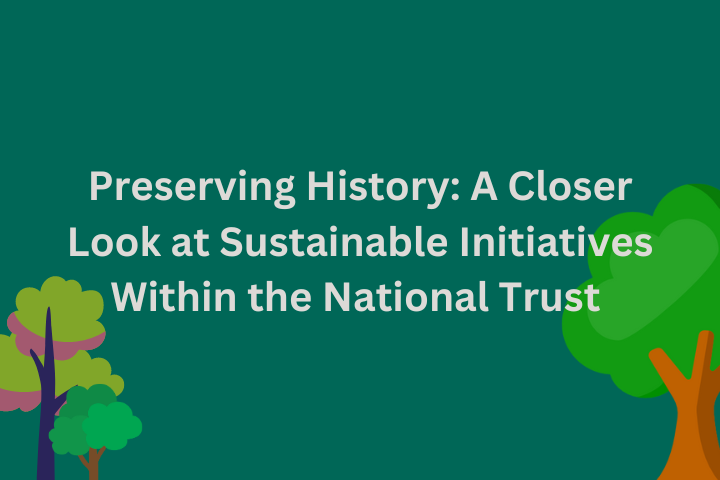Preserving History: A Closer Look at Renewable Initiatives Within the National Trust

You may be thinking, how isn’t the National Trust renewable?
It’s a good question – and we aren’t saying that it isn’t. Given the nature of the National Trust, many beautiful outdoor spaces exist for us to visit and enjoy. We want to help ensure that this beauty can continue for decades to come, and with the National Trust’s target to be Carbon net-zero target by 2030, moving towards renewable energy by implementing technology such as solar panels and heat pumps will allow that to happen.
Table of Contents
There are many country estates, museums, listed buildings and the like that all require some form of power, whether that’s electricity or gas. Implementing sustainable initiatives such as ground source heat pumps (GSHPs), air source heat pumps (ASHPs) and solar panels could mean that the UK’s heritage can be preserved even longer with the fantastic work of the National Trust.
There are almost 500 National Trust properties in the UK including historic houses and castles, and on the roster are even some famous filming locations – most notably Basildon Park in Downton Abbey!
The most recent sustainable project is that of Kingston Lacy in Dorset, a country house designed similarly to a Venetian palace, renowned for its opulent collection of paintings. Heating the mansion uses around 30,000 litres of oil annually, releasing around 80 tonnes of carbon each year. The National Trust has installed a high-temperature ground source heat pump system, their biggest heat pump project to date, and the project is said to reduce emissions from the estate to around 25% less than their current levels.
Many country houses such as Kingston Lacy are home to old and delicate objects, which is what makes them great places to visit. However, traditional heating methods such as using radiators with fuel-hungry boiler systems are not only environmentally unfriendly due to their reliance on fossil fuels but also pose challenges in preserving artefacts like paintings and books.
How Can Traditional Methods of Heating Damage Our Heritage?
The preservation of the National Trust sites is essential to keeping our heritage in its best condition, and turning to renewable energy sources can make preservation much more efficient.
John Gilham, our Group Technical Director and Renewable Energy Expert here at Green Building Renewables, explains that “Traditional heating methods, such as central heating systems with a typical boiler powered by fossil fuels, can dry out precious artefacts such as original tapestry and artwork.
“If not monitored, the heat produced by radiators can circulate the air, potentially drying out precious paintings and even causing the paint to crack, sometimes creating damage that can’t be repaired. This is because the heat from traditional heat sources like radiators is much more intense. The internal environment and climate of these buildings are essential for their preservation.
“Older buildings like the Trust’s country estates will also often have libraries full of old books, and central heating systems sometimes aren’t too kind on them. Heat pumps mean that these huge estates can be heated slower for longer whilst being much more cost-efficient, therefore allowing the humidity to be controlled in the internal ecosystem of the building.
“Ventilation in these buildings is key to preservation, as it’s so important to allow the heat to escape and fresh air to circulate the room to prevent damp. Rooms with poor ventilation can potentially lead to mould, and this could be very damaging to the artefacts.
“Transferring to a heat pump method of heating whether that’s ground or air source will be much kinder to the artefacts we are preserving, and also be more cost-efficient for the Trust in the long run. This will allow funds to be put into other environmental conservation, and not be eaten up by hungry heating and electric bills.”
The 10 Most Renewable National Trust Sites
We have discovered the top 10 most sustainable National Trust sites in the UK by revealing which sites have implemented the most renewable technologies, and are paving the way for a sustainable future.
(Image: National Trust)
The Kingston Lacy estate in Dorset is the most recent of the National Trust’s sustainability projects. Featuring a new ground source heat pump system that boasts 6000 metres of underground pipes, the estate can expect to save around 30,000 litres of oil each year. The mansion is known for its remarkable collection of paintings, and the heat pump will ensure a safer internal environment to ensure the collections are preserved for many more years to come.
(Image: National Trust)
The National Trust has a Renewable Energy Investment Programme, and because of this, Wimpole Estate has seen the installation of solar panels, air source and ground source heat pumps. The visitor site is now heated by an air source heat pump, and both the estate and restaurant are powered by the new ground source heat pump, expecting to save around £8000 a year in fuel costs by replacing the old oil-fueled boiler.
(Image: Wikipedia)
Thanks to a £1.8 million grant from the Heritage Lottery Fund along with donations, the 17-bedroom mansion in South Worcestershire was able to undergo several repair works as well as a brand new ground source heat pump system. The National Trust say these works were to reduce reliance on fossil fuels, and due to the nature of the historic building, the internal environment mustn’t become too humid. The heat pump installation will allow the building to maintain consistent optimal temperature and humidity levels, therefore preserving the history in the best way possible.
(Image: Wikipedia)
Having had numerous renewable energy systems installed including solar panels, the castle now generates more energy than it uses. The greenhouses which date back to before 1900 are powered by solar panels and heated by air source heat pumps.
(Image: National Trust)
Anglesey Abbey is a country house with a working watermill, along with impressive grounds. The site is powered by both solar panels and a water source heat pump, and impressively, the electricity generated is enough to supply the average energy needs of 11 UK homes. With the water source heat pump and solar panels, the trust has been provided with over 230,000 kWh of renewable energy each year.
(Image: National Trust)
With a resemblance to a Norman castle, Penrhyn Castle has undergone several projects to help reduce its carbon footprint, including the installation of half an acre of solar panels and a renewable heating system. Art exhibitions and walled gardens make it a popular visit for a day out, and the site was the last National Trust mansion to use oil fuel in its heating system.
(Image: National Trust)
Two oil-fired boilers were removed to make room for a biomass one at this site, once home to Lord Nuffield, founder of the Morris Motor Company, and his wife Elizabeth. A biomass boiler works by burning wood pellets or chips, and converting this energy into the heating used for the house.
(Image: National Trust)
In 2023 solar panels were installed on the visitor roof, with an expected saving of £3,500 each year on electricity costs for the building. Ground source heat pumps were also installed in the visitor building, and other sustainable initiatives have also been taken such as draught-proofing to help the Trust hit its Carbon net-zero target by 2030.
(Image: National Trust)
Gibson Mill, located on the Hardcastle Craggs site, was one of the UK’s first mills to power the Industrial Revolution. A solar panel and battery storage system were introduced, as well as a wood-fuelled boiler to power the hot water for the cafe that sits on site. It is also powered completely off the grid, meaning it isn’t connected to mains power, water, or sewage. The mill is run almost completely self-sufficiently, making it a unique National Trust site.
(Image: National Trust)
The Blickling Estate in Norfolk boasts a vast space of different landscapes such as lakes and woodlands ready to be explored. The lake, whilst being home to an array of different wildlife, is also part of the Trust’s renewable energy programme. A water source heat pump was fitted in 2016, and the estate now saves around 69 tonnes of carbon emissions each year, powering the house and offices that are on site.
Visiting Heritage Sites and Cultural Attractions Are at the Top of Britain’s Priorities This Summer
Visiting sites of cultural significance plays a huge part in British tourism, and the National Trust is home to many areas of significance, with natural beauty that walkers and adventurers can explore to their hearts’ content. In fact, sightseeing famous monuments and buildings is the 3rd most popular visitor activity in Britain.
New research by Green Building Renewables has discovered that when looking at the types of days out this summer, 29% of Brits are prioritising visiting heritage sites. 25% are looking to visit cultural attractions, whilst just 13% are more interested in exploring nightlife, and 12% are looking to go shopping when visiting other places in the UK.
Being outdoors is also scientifically proven to improve a person’s well-being, and studies have shown that there is an inverse association between spending time outside and improving mental health. Proximity to greenspace has been associated with lower levels of stress as well as reducing the symptoms of depression and anxiety, making spending more time outdoors a more popular way of spending free time, especially during the summer.
Interested in learning more about how sustainable technologies can pave the way for a more renewable future? You can read all about the benefits of solar panels here, as well as brush up on all things ground source heat pumps and exactly how they work. If you’re looking at going green yourself and want some more information, then don’t hesitate to get in touch for your free, no-obligation quote.




